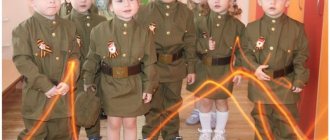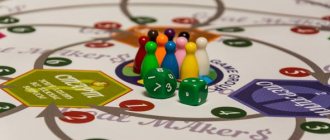Forms of work on the development of speech of preschoolers in the context of the introduction of the Federal State Educational Standard for Education
Forms of work on the speech development of preschool children in the context of the introduction of the Federal State Educational Standard for Preschool Education
According to the Federal State Educational Standard for Preschool Education (FSES DO): “speech development includes mastery of speech as a means of communication and culture; enrichment of the active vocabulary; development of coherent, grammatically correct dialogical and monologue speech; development of speech creativity; development of sound and intonation culture of speech, phonemic hearing; acquaintance with book culture, children's literature, listening comprehension of texts of various genres of children's literature; the formation of sound analytic-synthetic activity as a prerequisite for learning to read and write” [5].
The communicative competence of a preschooler is manifested in the ability to solve problems through speech in different types of activities: everyday, cognitive, play, educational, work, etc. In this case, the child focuses on the special conditions of the situation in which the activity takes place.
In order for the child to achieve communicative competence, the teacher helps its development by solving problems for the development of different aspects of the child’s speech in all age groups: the development of coherent speech, the development of vocabulary, the development of grammatically correct speech, the development of sound culture of speech, preparation for learning to read and write. The construction of the educational process should be based on age-appropriate forms of working with children. The choice of forms of work is carried out by the teacher independently and depends on the number of students, the equipment of the preschool institution, cultural and regional characteristics, the specifics of the preschool institution, and the experience and creative approach of the teacher.
The leading form of work on the development of children's speech is the educational situation. An educational situation involves the participation of a small subgroup of children: from three to eight, depending on the wishes of the children and the characteristics of the content of the situation. In the educational process, it is possible to organize several educational situations with one didactic means (a plot picture, a toy, a book, natural material), but with the aim of solving gradually more complex tasks of a cognitive-speech nature. The teacher can organize many educational situations aimed at solving gradually more complex problems: teaching methods of friendly business communication with an interlocutor, teaching how to ask questions, arranging them in a logical sequence, learning to summarize the information received into a single story, teaching methods of presenting a compiled text. “Good greetings” (goal: to introduce children to various forms of greeting: “I’m so glad to see you,” “How I missed you,” “Infinitely happy to see you,” “It’s so good that we met,” etc.);
O.M. Eltsova notes that a game-based learning situation (GTS) is used to develop game communication. All qualities and knowledge are formed not by the ITS itself, but by one or another specific content that is specially introduced by the teacher. Types of game learning situations can be: illustration situation, assessment situation, etc.
A.G. Arushanova offers scenarios for activating communication as a form of speech development for children - teaching playful (dialogical) communication. This form includes conversations with children, didactic, active, folk games; staging, dramatization, examination of objects, etc.
A communication situation is a form of communication specially designed by a teacher or arising spontaneously, aimed at training children in using mastered speech categories (Eltsova O.M., Gorbachaya N.N., Terekhova A.N.). Communication situations can be lexical, verbally evaluative, prognostic, collision, descriptive, depending on the assigned speech task. When organizing them, most often the teacher “comes from the children,” that is, he finds these situations in children’s activities and uses them to develop the child’s speech. Examples of communication situations for the development of communication skills could be: “What’s wrong?” (goal: to train children in the ability to correlate the form of greeting with the situation of its use: each greeting is appropriate in one situation or another: you cannot say “good evening” in the morning; you cannot say “hello” to someone who is older or less familiar); “Smile” (goal: to practice using non-verbal communication means when greeting: look a person in the eyes and smile so that he understands: he is welcome, he is the one being greeted); “Handshake” (goal: to train children in using forms of gesture greeting) [1].
It is in these types of children's activities that speech appears in all its diverse functions and bears the main burden in solving practical and cognitive problems. Examples of specially planned communication situations can be quiz games: “Come up with a riddle” (an exercise for children in describing objects, inventing riddles), “Who knows their city better” (an exercise in perceiving and composing descriptive stories about places and monuments of the city), “From what kind of fairy tale things" (an exercise in the development of explanatory speech), "The Shop of Magic Things" (an exercise in the use of means of linguistic expressiveness).
A number of authors (L.S. Kiseleva, T.A. Danilina, T.S. Lagoda, M.B. Zuikova) consider project activities as a variant of an integrated method of teaching preschoolers, as a way of organizing the pedagogical process, based on the interaction of teacher and student, step-by-step practical activities to achieve the set goal. The implementation of the educational field “Speech Development” is possible through the project method. The purpose and objectives of the special thematic project are aimed at a comprehensive solution of the problems specified in the Federal State Educational Standard for Education: “How a book is born” (goal: development of children’s speech creativity. The product of the project is author’s children’s books of fairy tales, riddles, limericks); “Is it better on your own or all together?” (goal: development of regulatory and communication skills (jointly solve everyday and educational problems, trust, support partners in activities); “Good and bad debate” (goal: mastering the etiquette of persuasion and argument) [3].
This form of speech development in preschoolers as a game encourages children to make contacts and is a motive for communicative activities. O.A. Bizikova offers games with ready-made texts: moving “King”, “Kite”, “Snake”, “Foxes”, etc.; didactic “I was born a gardener”, “Colors”, “Smeshinki”, etc. (master the variety of initiative and response remarks, become familiar with the implementation of the basic rules of dialogue); didactic games that involve dialogic interaction, but do not contain ready-made remarks: “Who will confuse whom”, “Order”, “Alike - not alike”, “Help yourself to a pie”, games with the phone “Calling a doctor”, “Calling mom at work”, "Bureau of Good Offices"
Kuzevanova O.V., Koblova T.A. give examples of different forms of work for the speech development of preschool children: literary and musical festivals, folklore fairs, dramatization games, different types of theaters, propaganda teams, social events, speech newspapers, homemade books, problem situations, gatherings, logo corner, interactive speech stands, calendar of events and others [2].
LEGO constructors are widely used in preschool educational institutions. They represent a variety of thematic series, designed on the basis of basic building elements - multi-colored Lego bricks.
Developing the speech creativity of preschoolers, the teacher can invite children to come up with a fairy tale about how one building turned into another, carrying out this transformation in the course of the story.
The created buildings from LEGO can be used in theatrical games, in which the content, roles, and game actions are determined by the plot and content of a particular literary work, fairy tale, etc., and there are also elements of creativity. While constructing, children create a three-dimensional image, which helps them better remember the image of the object. The child talks more willingly about the horse he made himself, comes up with different stories, etc.
This use of LEGO construction also promotes verbal creativity: while building a character, the child describes his hero. You can also invite children to come up with their own ending to a familiar fairy tale, act out the best one, or do everything in turn.
LEGO elements are also used in didactic games and exercises. A teacher can develop various manuals and use them to conduct exercises to develop speech and mental processes in children, develop interest in learning, and form a communicative function. For example, the game “Wonderful Bag”, in which children develop tactile perception of shapes and speech, can be played with LEGO.
The use of didactic exercises using LEGO elements is quite effective when conducting classes in preparation for learning to read and write, correcting sound pronunciation, familiarizing with the outside world, etc.
In the process of constructive play activities, the teacher, relying on the involuntary attention of children, activates their cognitive activity, improves the sensory-tactile and motor sphere, forms and corrects behavior, develops the communicative function and interest in learning. In the process of constructive play activities with LEGO, the teacher can use a variety of forms: tasks are given by the teacher, completed by children; tasks are formulated by the child and completed by the children and the teacher; children give each other tasks; The tasks are given by the teacher and completed by the parents and the child.
Pozdeeva S.I. o[4].
Thus, various forms of work are resourceful in terms of the development of speech in preschoolers and the formation of children’s communicative competence, if:
- children jointly solve an educational and gaming task that is interesting and meaningful to them, acting as assistants in relation to someone,
— enrich, clarify and activate their vocabulary by performing speech and practical tasks,
— the teacher is not a tough leader, but an organizer of joint educational activities, who does not advertise his communicative superiority, but accompanies and helps the child become an active communicator.
Literature
- Eltsova O.M., Organization of full-fledged speech activity in kindergarten / O.M. Eltsova, N.N. Gorbachaya, A.N.. Terekhova - St. Petersburg: CHILDHOOD-PRESS, 2005.-192s
- Kuzevanova O.V., Forms of organizing communicative activities of preschool children / O.V. Kuzevanova, T.A. Koblova. // Kindergarten: theory and practice – 2012. – No. 6.
- Project method in the activities of a preschool institution: Pos. for managers and practical workers of preschool educational institutions / Author: L.S. Kiseleva, T.A. Danilina, T.S. Lagoda, ; M.B. Zuikova: Arkti, 2005.
- Pozdeeva S.I. Open joint action of the teacher and the child as a condition for the formation of communicative competence of children / S.I. Pozdeeva // Kindergarten: theory and practice. - 2013. - No. 3.
- Federal State Educational Standard for Preschool Education /https://www.rg.ru/2013/11/25/doshk-standart-dok.html



